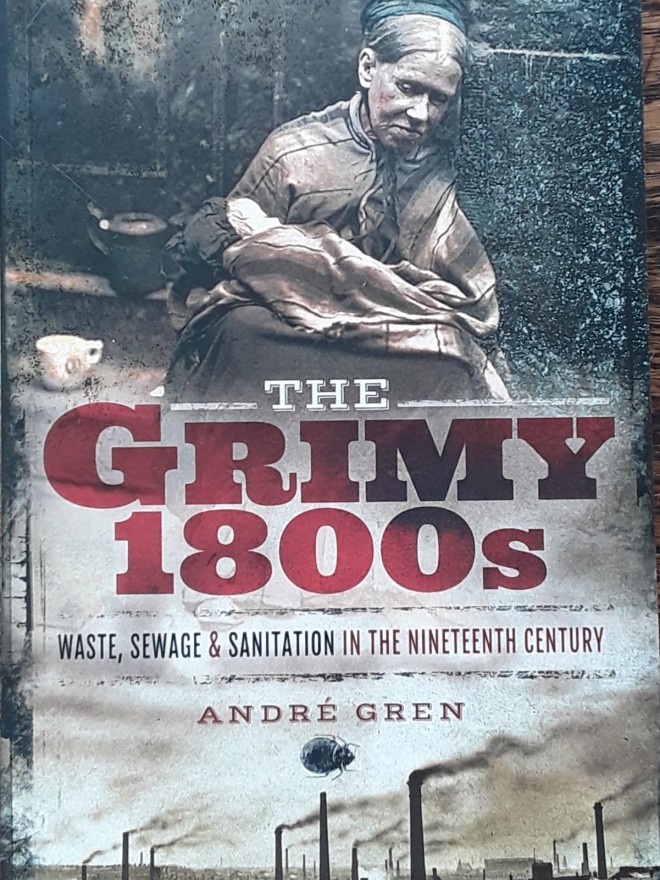
Reviewer: Michael Keith
Title: The Grimy 1800s: Waste, Sewage & Sanitation In The Nineteenth Century
Author: Andre’ Gren
Number of Pages: 117
Rating Scale (1: Very poor, 10 Excellent): 4
_____________________
When writing in this volume’s Introduction, the author notes that ‘Thus book does not attempt to offer an authoritative account of the reasons for the growth in Britain’s population in the nineteenth century [sic] but concentrates instead on the consequences of that growth and the increasing need for what was called ‘nuisance control’. The result is a ‘…Series of snapshots from Britain, which was struggling to cope with rampant population growth and urbanization…’ It is a fair summary of what is to follow.
Within the volume, an Acknowledgements section placed immediately behind the Contents pages thanks those individuals and organisations who assisted in this book’s creation. The volume’s Introduction follows and précis the 14 Chapters which form its largest section. These now appear. With the exception of Chapter 1 (Nuisance Control and Removal in Nineteenth–Century Britain), which provides a general background concerning the legislation which is about to be discussed, each of these is devoted to a specific subject. The subjects are diverse and range from Grime: Wells, Drains and Discharges (Chapter 3), to Human Waste: Water Closets and Shrimps (Chapter 8) to Burial Grounds (Chapter 14). Essentially, if it involved ‘Dirt’ in any form it will be discussed. The Chapters themselves follow an interesting format, and, for this reviewer, reveal a major flaw. In respect of the format, within each Chapter, several specific Bills relevant to the subject under discussion are presented. These relate to specific locations. As part of the legislative process, the sites to which specific Bill related were visited by a Committee of Review; the intention being to obtain local feedback to what was proposed by the legislation. The volume is essentially a collection of the responses by local officials to that process. A small Table placed below each Bill subheading, shows the population growth of the area concerned. A section titled Conclusion follows Chapter 14 (Burial Grounds), and as the title suggests, acts as a summary of what has gone before. This is followed by three Appendices. These are variously of Table and Column format and cover Population Growth (Appendix 1), Occupations of the Witnesses (Appendix 2) and Locations to Which the Evidence Secessions Relate (Appendix 3). Appendix 3 is followed by the Index; the volume’s last section. Eight pages of images appear in a dedicated section in the centre of the volume. These are monochrome in format and accompanied by informative captions. None carry Source Citations, although the author does note (On the Acknowledgements page) that ‘The selection of illustrations was eased by assistance from Rav Gopal at Newbury Library’. neither the Contents nor Index sections carry reference to the existence of these images. The volume contains neither Maps or Bibliography, and where Quotes appear within the work, they are not supported by authenticating citations. They might just as well be imagined.
Although this volume is well-written and easy to read, for this reviewer the complete lack of authenticating and supporting documentation in the form of Citations and reference material raises severe concerns about its authority. Put simply, there is no way of knowing if what is presented as ‘fact’ is actually ‘true’ and an authentic record, or just a convenient ‘imagining’ to fit a predetermined narrative. For a volume purporting to be a ‘Work of historical significance’ this is a major failing, and on that basis (the complete lack of any authenticating documentation), this reviewer found it difficult to not conclude that the result is, at best, a highly-imaginative work of fiction. Failings in the volume’s Index only serve to compound the problem, with random checking finding numerous situations where items appearing within the narrative were not accorded the courtesy of an Index entry. The discovery that (for example) there were no Index entries for Playfair, Museum of Geology, Liverpool Corporation Waterworks Bill, House of Commons and Department of Woods and Forests (all on page 37) raised additional questions about what else may have been omitted from the Index, and, inter alia, about its authority and veracity. There is no way to know, but as subsequent random checking for other entries produced a similar result, the problem would seem to be widespread. The above, when combined with the previously-noted lack of verification for the Quotes appearing within the work, has resulted in what could at best be described as ‘A collection of interesting stories.’
As previously-noted, this volume is well-written and easy to read. As a result, it may well appeal to readers who are seeking a ‘once over lightly’ view of life in Nineteenth-Century Britain\, with the qualification that there is no way of knowing if any of what is written is actually true or accurate. This complete lack of supporting, authenticating, citations also means that, for Historians, the work has little value and is very definitely not to be considered ‘Authoritative’ in any way.
On a Rating Scale where 1: Very poor, 10 Excellent, I have given this volume a 4.
Were that that was not the case.
_________________________________








